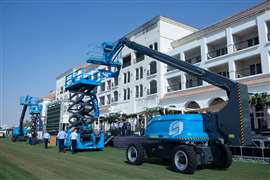New frontier for Buckner
13 September 2010

Buckner Companies is using its new Liebherr LR 1600/2 crawler crane to install vessels and components on the A-3 Test Stand at NASA's John C. Stennis Space Center, Bay St. Louis, Mississippi, USA.
Working in conjunction with contractors Beyel Brothers and American Tank and Vessel, Buckner's 600 tonne capacity LR 1600/2 crawler is tasked with lifting vessels and other components weighing up to 400,000 pounds (181 tonnes).
Scheduled for completion in 2012, the A-3 Test Stand will allow NASA to test engines at simulated altitudes of up to 100,000 feet (30,480 m). According to information published by Stennis Space Centre, such testing is critical for engines that will carry humans beyond low-Earth orbit. The new facility is the first large test facility to be built at Stennis since the 1960s.
Buckner took delivery of the first LR 1600/2 in the USA in October 2009. It is now rigged in SDBW/W configuration. "That is the heaviest lift configuration for the crane, and includes the main boom, the luffing jib with derrick attachment and ballast wagon," says Jerry Masten, project manager for Buckner Heavylift Cranes, a division of Buckner Companies.
Masten says the crane is rigged using 197 feet (60 m) of main boom and 118 feet (36 m) of luffing jib. The full complement of boom and jib will reach tip heights of 630 feet (192 m). The ballast wagon is designed for up to 772,000 pounds (350 tonnes). On the main crane the counterweight is designed for up to 331,000 pounds (150 tonnes) and the carbody at 143,300 pounds (65 tonnes). "For maximum lifting capacity you would utilize all of that counterweight," Masten explains.
"Hurricane season is upon us and we have a safety plan developed in case of that," adds Masten. "Being right on the Gulf, storms blow up in an hour or two it can be black as night. With the ballast wagon attached, we can lower the boom in 45 minutes if we need to do so. "
The manufacturer's Liccon system is also significant in such conditions. "This crane gives us so much more information regarding environmental conditions. The operator is getting the wind speed at the tip of the main boom at all times, so we can tell what's going on more so than ever before, with the sensors integrated up and down the boom structure feeding information back to the computer systems on these cranes. Liebherr's Liccon system has been upgraded for this crane and the changes are significant. It's proven to be spot-on in terms of weights being lifted, positioning of the Ballast Wagon, ground bearing pressures, and wind sensors."






